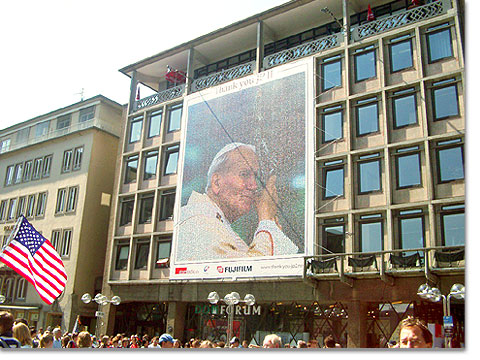The Radiation of Fatherhood
A play written by John Paul II staged at Trinitatis – Schoenstatt live!

Juan Pablo II, autor del teatro
John Paul II, author of the theatre piece
Johannes Paul II, Author des Theaterstücks
Fotos: POS Fischer © 2005
| published: 2005-08-20 |
The Radiation of FatherhoodA play written by John Paul II staged at Trinitatis – Schoenstatt live! |
 Juan Pablo II, autor del teatro John Paul II, author of the theatre piece Johannes Paul II, Author des Theaterstücks Fotos: POS Fischer © 2005
|
WYD-COLOGNE,Ann Winzenburg. A theater cast from the University of Glasgow gave the Schonstatt stage at Trinitatis Church an international feel. The message of the Scottish actors and actresses was universal as they performed The Radiation of Fatherhood, a play by Pope John Paul II. "The universal truths that carry through the thought of John Paul II appeal to everyone," said director Stephen Callaghan, adding that the play can transcend differences in language, faith, and culture. The play´s audience included the Archbishop of Glasgow Mario Joseph Conti and youth from various countries, both English and non-English speaking. The voices of the cast engaged, delighted, and challenged the audience and those unfamiliar with Scotland. One might say the ideas of the Pope, in any language, are challenging. Callaghan said the play, written in the sixties, is challenging but also powerful and simple. ´´It presents a very powerful image of a gentle, loving father,¨ Callaghan said. The actual character of the father is not always gentle and loving, but he learns. As the title suggests, Adam must learn about how God the Father radiates through him. The lesson is hard learned. Adam rebels against his responsibility as a father and questions God. His daughter and wife must both struggle with the source of Adam´s strife: his continual choice to be lonely. Adapted for a contemporary audienceThe producer, Fr. John Keenan, said of this central problem, ¨A great temptation is to be independent and to be free from all ties, but the great vocation is to die to our independent selves and to give ourselves as an act of total love.¨ In the end, the actors used their movement and simple props to represent this idea and other ideas: everyday, psychological, and spiritual. Callaghan said he needed to ask himself, ¨How can I make Adam appear as an ordinary man and as the biblical father of humanity?¨ In the end, the director adapted the play for a contemporary audience. He added some scenes to expand the play and reflect the late Pope´s life. For instance, Adam meets his wife when he is hit by a car, a scene remembering the Pope´s rescue after he was hit by a Nazi vehicle. Callaghan also increased the cast size from three and a chorus to ten. The expanded cast divided up some of the original monologues, such as one Adam´s longer monologues. It was divided between Adam and different sides of his personality, Inward Adam and Outward Adam. His inward person wanted to withdraw and hide, and Callaghan himself represented this aspect of Adam by cowering and nodding downward with his head. Meanwhile, the outward aspect wanted to impress the world with bravado and dramatic hand gestures. Inward Adam and Outward Adam wore black and stood behind the original character, who wore modern street clothes. "We discover in Pope John Paul II the questions in every young heart."The expanded cast also helped portray the spiritual scenes in the play. In one scene, a viper-like character with hideously long finger nails attacks Monica, Adam´s daughter. Adam, of course, rescues her, and his dialogue meaningfully includes ¨mine,¨ a word he has avoided because of its connotation of responsibility. In yet another scene, a cast of actors wearing black stood interwoven with each other, their bodies forming a twisting tree trunk and their arms the eight branches of a tree with six apples. They glare at the audience until Adam chooses an apple. Then, the actors collapse with Adam and show sad expressions. ´¨In the end, Adam discovers that God is independence," Keenan said. He later added, "We discover in Pope John Paul II the questions in every young heart." |
Zurück/Back: [Seitenanfang
/ Top] [letzte Seite / last page]
[Homepage]
Last Update:
20.08.2005
Mail: Editor /Webmaster
© 2005 Schönstatt-Bewegung in Deutschland, PressOffice Schönstatt,
hbre, All rights reserved, Impressum